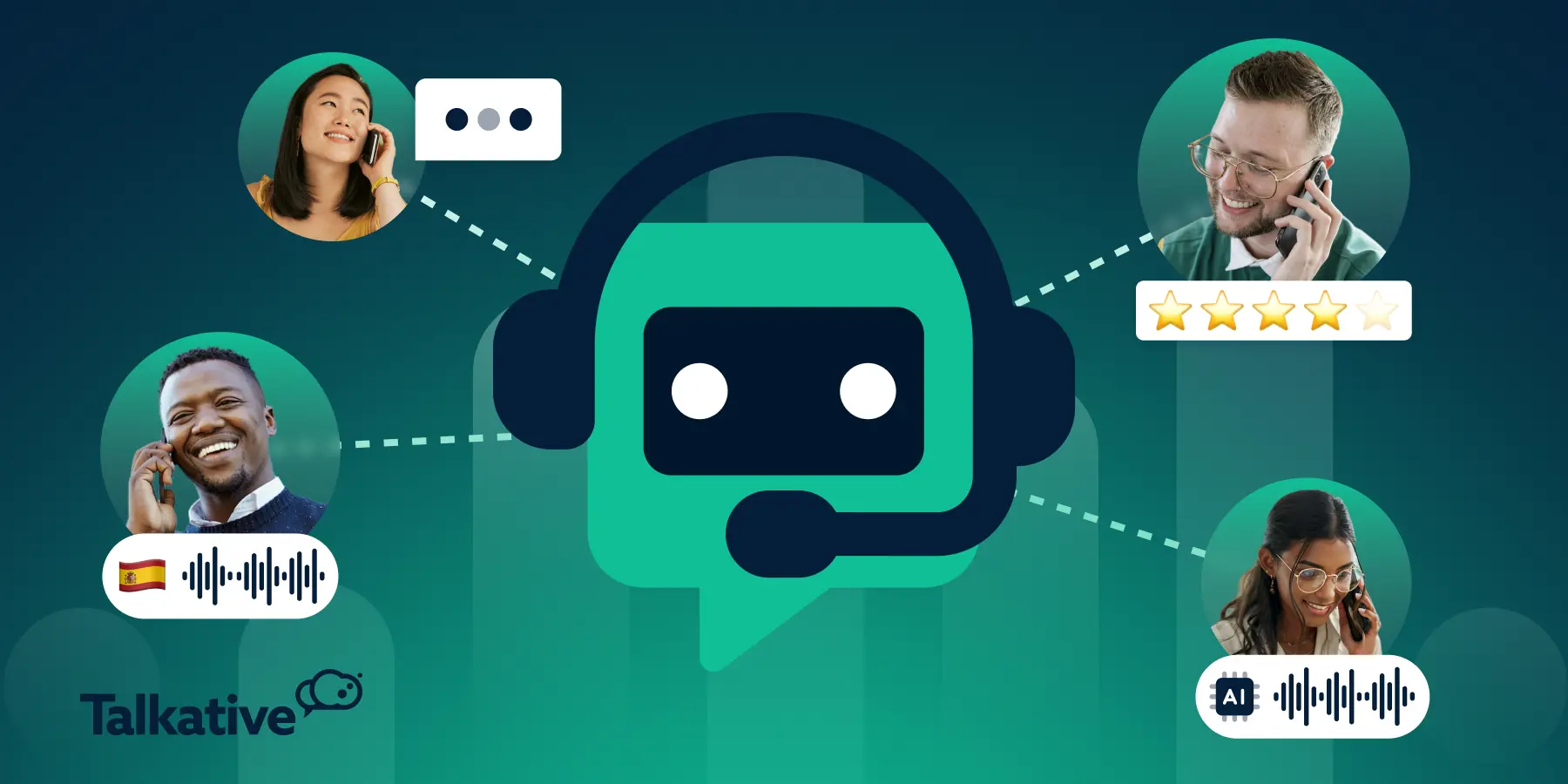How Voice AI for Customer Support Enhances Service Quality and Lowers Operational Costs
Customer expectations are higher than ever. They want support that’s instant, human-like, and always available. Traditional contact centers struggle to deliver that level of responsiveness while keeping costs down. High call volumes, repetitive queries, and agent burnout lead to slower resolutions and inconsistent experiences.
Enter voice AI for customer support, a new generation of intelligent voice agents that transform how businesses manage customer interactions. These systems understand natural speech, detect intent, and resolve issues in real time without adding to the agent workload.
This blog explores how enterprises across industries are using voice AI to enhance service quality, improve efficiency, and reduce operational costs.
The Shift from Call Centers to Intelligent Voice Systems
Voice AI is reshaping how customer support operates. Unlike IVR menus or scripted bots, AI-driven voice systems can handle open-ended questions, provide contextual responses, and transfer complex cases to humans seamlessly.
Key drivers behind this shift include:
- Rising expectations for personalized, always-on service
- Difficulty scaling human support teams during peak demand
- Growing pressure to reduce average handling time (AHT) and cost per interaction
According to recent data, AI-enabled customer service teams have saved 45% of the time spent on calls and resolved issues 44% faster, resulting in major operational cost reductions.
How Voice AI Enhances Service Quality
Modern AI systems don’t just automate; they enhance the customer experience by combining contextual understanding with empathy and personalization.
1. Real-Time Understanding of Customer Intent
Voice AI can analyze tone, sentiment, and keywords in real time. This allows the system to determine whether the customer is frustrated, confused, or simply looking for quick information.
- Escalations are prioritized based on urgency.
- Customers receive faster, more relevant answers.
- Agents are better prepared with conversation insights when taking over.
2. Personalized Responses at Scale
Voice AI uses customer history and CRM data to personalize interactions. Instead of repeating account details, customers receive context-aware assistance.
- AI greets users by name and references past purchases or issues.
- Repetitive verification steps are minimized.
- Follow-ups are consistent with previous communications.
3. Consistent and Error-Free Interactions
Unlike human agents, AI doesn’t fatigue or misinterpret data. This consistency ensures high-quality responses across all time zones and channels.
Lowering Operational Costs Through Automation
Operational efficiency is a key reason enterprises adopt voice AI. It reduces dependency on large support teams while improving customer satisfaction.
1. Intelligent Call Routing
AI classifies queries and directs them to the right department instantly. This eliminates long wait times and reduces the number of unnecessary transfers.
2. First-Contact Resolution (FCR) Boost
With real-time data access and intelligent workflows, AI resolves simple to moderately complex issues without human input. Higher FCR directly reduces costs and improves customer loyalty.
3. Scalable Workforce Efficiency
AI handles routine inquiries 24/7. Human agents can then focus on high-value conversations like escalations, upsells, or retention cases.
Example Table: Cost Reduction Overview
| Operational Area | AI Impact | Cost Reduction Outcome |
| Call Handling Time | 45% faster resolution | Lower AHT and fewer shifts |
| Agent Workload | 30% reduction in repetitive tasks | Reduced burnout and turnover |
| Customer Retention | Higher satisfaction from quicker responses | Increased loyalty and repeat business |
The Technology Driving Voice AI
Behind every efficient AI voice system is a blend of speech recognition, NLP (Natural Language Processing), and sentiment analytics.
1. Speech Recognition and Natural Language Processing
Voice AI converts speech to text with high accuracy, even in noisy environments. NLP interprets context and intent, enabling the AI to handle complex dialogues.
2. Machine Learning for Continuous Improvement
Every conversation helps the AI learn. Over time, it improves its response accuracy and adapts to customer preferences.
3. Integration With CRM and ERP Systems
When connected to internal systems, AI can access order status, billing details, or policy information instantly. This reduces agent dependency and enhances resolution speed.
The Global Rise of Voice Technology
The adoption of voice AI is part of a larger global trend. According to market data, the global voice recognition tech market reached nearly $12 billion in 2022 and is projected to grow to almost $50 billion by 2029.
This surge shows that voice-based customer interactions are not just a trend—they’re becoming a standard part of enterprise operations. Businesses that adopt early gain a competitive edge in service quality and cost control.
Building a Hybrid Support Model
Voice AI doesn’t replace human agents. It complements them by creating a hybrid model where automation and empathy work side by side.
How Hybrid Models Work
- AI handles FAQs, account updates, and scheduling.
- Humans step in for emotional or complex cases.
- Supervisors use AI dashboards to track performance and optimize workflows.
Benefits of Hybrid Support:
- Round-the-clock availability
- Faster query handling without quality loss
- Better agent productivity through reduced workload
Measuring ROI from Voice AI
Businesses are finding measurable benefits from deploying voice AI in customer support. The ROI typically comes from three primary sources:
- Operational Savings: Lower staffing requirements and reduced call volumes.
- Improved Customer Satisfaction (CSAT): Faster resolutions and personalized experiences.
- Agent Productivity: Shorter call durations and improved focus on high-value interactions.
Key Metrics to Track:
- Average Handling Time (AHT)
- First-Contact Resolution (FCR)
- Customer Satisfaction (CSAT)
- Cost Per Interaction (CPI)
By tracking these metrics, enterprises can evaluate how voice AI drives both efficiency and experience gains.
Future Outlook: Smarter, More Empathetic Voice Systems
Voice AI will soon go beyond scripted responses to offer emotionally intelligent assistance. Systems will detect hesitation, frustration, or urgency from tone and adjust responses accordingly.
Upcoming innovations include:
- Predictive assistance: AI anticipates needs before customers ask.
- Multilingual fluency: Expands support for diverse customer bases.
- Integrated analytics: Provides leaders with insights to refine training and workflows.
As these advancements mature, voice AI will move from being a cost-saving tool to becoming a strategic enabler of customer experience excellence.
Getting Started with Voice AI
Implementing voice AI doesn’t require a full system overhaul. Businesses can begin with pilot programs targeting high-volume areas like order tracking or billing queries.
Steps to Begin:
- Identify repetitive or high-cost support tasks.
- Integrate voice AI into existing CRM and ticketing systems.
- Train teams to interpret AI analytics for continuous improvement.
- Measure KPIs and scale based on impact.
Starting small allows businesses to prove ROI and build confidence before expanding across all service channels.
Conclusion: Voice AI as the Future of Scalable Support
Voice AI for customer support has become an essential tool for businesses that want to deliver fast, accurate, and human-like service without the burden of rising costs. It automates routine calls, supports agents with real-time data, and ensures that every customer feels heard.
As AI continues to evolve, the balance between automation and empathy will define the next generation of customer experience. Companies investing now will build support systems that are not only efficient but truly customer-centric.






